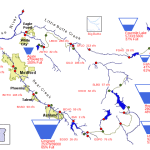Disastrous Loss of Homes to Wild Fires Triggers Action
Wildfires of Labor Day 2020 were the most significant set of disasters ever to hit Oregon. Around 3,800 structures were lost across Jackson, Lane, Clackamas, Linn, Lincoln, and Marion Counties; around 2,400 homes burned in Talent and Phoenix, displacing around 6,000 people. At least 1,500 of the homes lost housed low-income families, many of them Latinx. 15 mobile home parks were wiped out entirely. 85% of students in affected school districts lack permanent housing. Jackson County provides a useful, but staggering resource that shows both a macro and micro (address by address) view of the devastation.
Grappling with meeting temporary housing needs alone will be a daunting task. It must be done with permanent solutions in mind, but also to meet the whole range of short- and long-term community needs. In the near term, we need to produce safe shelter beyond fairgrounds, motel rooms, and “couch-surfing” with likely already overcrowded friends and family. It will take years for permanent solutions, but it will be essential to ensure that adequate temporary and permanent housing match the income capabilities of those who need it. Urgency must be carefully tempered with vigilance to prevent building of unaffordable units that benefit developers at the expense of displaced families.
While we’re all in the grip of the emotions of this tragedy, the rather bureaucratic-sounding concept of land use law is central. It’s also an area about which the LWV has positions. Peggy Lynch, LWVOR Natural Resources Action Coordinator, is following action on the state level closely and reports that dealing with housing recovery will mean the most significant changes to those laws since their inception. But before that can occur in the 2021 Session, the first step is discussion of a set of Temporary Rules that will help address immediate housing needs. The Land Conservation and Development Commission (LCDC) will consider that in early October. Such rules remain in effect for a maximum of 180 days so will need to be revisited at that time.
Decisions will not be easy. While some appear to want a general and thoroughgoing waiver of rules, actions must not sacrifice public health and safety. Asbestos and other toxic materials will take months to remove before rebuilding can begin. Besides FEMA and the County, LCDC, the Department of Environmental Quality, the Oregon Housing Authority, and Building Codes Division will need to be involved. Various entities on local levels and elected officials on all levels must coordinate and collaborate carefully on this and many other related issues if unintended consequences are to be avoided.
“I am only one, but still I am one. I cannot do everything, but still I can do something. And because I cannot do everything I will not refuse to do the something that I can do.” – Helen Keller
LWVRV September, Newsletter 2020





